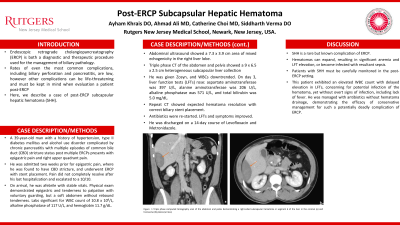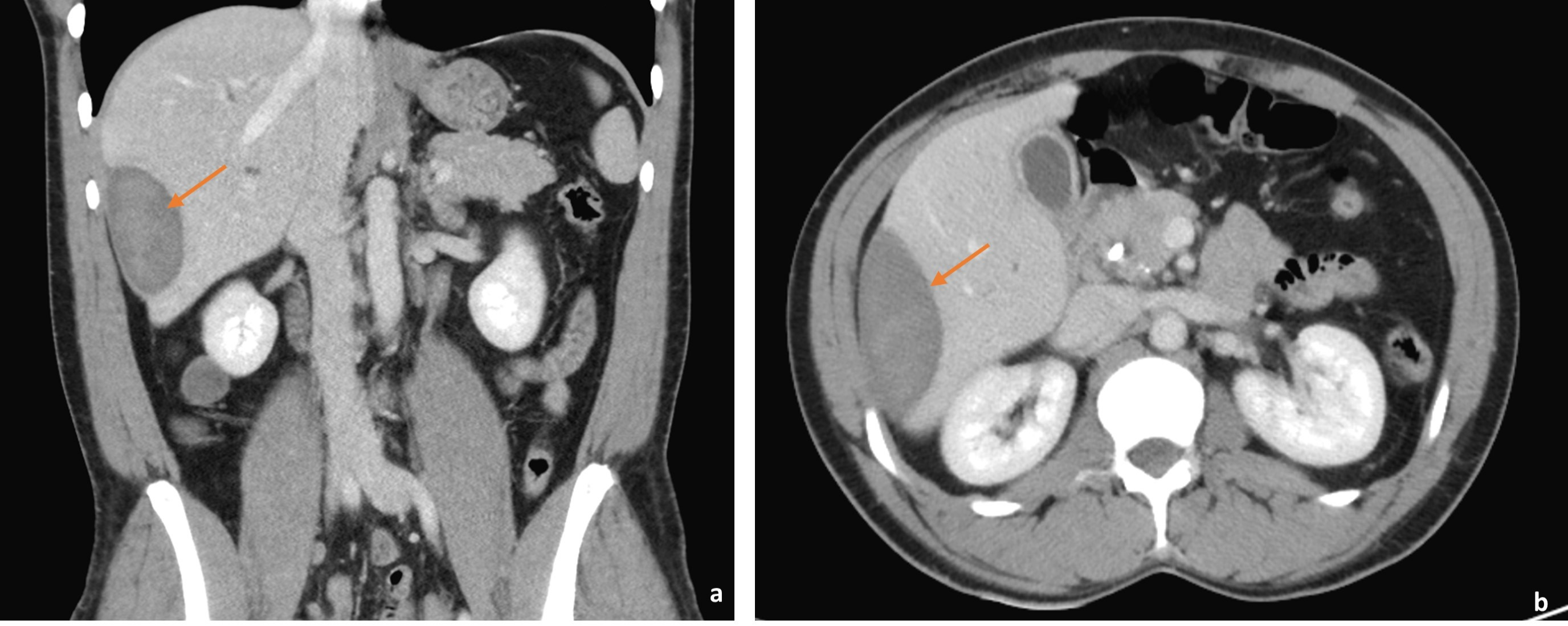Back


Poster Session B - Monday Morning
Category: Interventional Endoscopy
B0479 - Post-ERCP Subcapsular Hepatic Hematoma
Monday, October 24, 2022
10:00 AM – 12:00 PM ET
Location: Crown Ballroom

Has Audio

Ayham Khrais, DO
Rutgers New Jersey Medical School
West Orange, New Jersey
Presenting Author(s)
Ayham Khrais, DO1, Ahmad Ali, MD2, Catherine Choi, MD2, Siddharth Verma, DO2
1Rutgers New Jersey Medical School, West Orange, NJ; 2Rutgers New Jersey Medical School, Newark, NJ
Introduction: Endoscopic retrograde cholangiopancreatography (ERCP) is both a diagnostic and therapeutic procedure used for management of biliary pathology. Rates of even the most common complications, including biliary perforation and pancreatitis, are low, however other complications can be life-threatening and must be kept in mind when evaluating a patient post-ERCP. Here, we describe a case of post-ERCP subcapsular hepatic hematoma (SHH).
Case Description/Methods: A 39-year-old man with a history of hypertension, type II diabetes mellitus and alcohol use disorder complicated by chronic pancreatitis with multiple episodes of common bile duct (CBD) stricture status post multiple ERCPs presents with epigastric pain and right upper quadrant pain. He was admitted two weeks prior for epigastric pain, where he was found to have CBD stricture, and underwent ERCP with stent placement. Pain did not completely resolve after his last hospitalization and escalated to a 10/10. On arrival, he was afebrile with stable vitals. Physical exam demonstrated epigastric tenderness to palpation with voluntary guarding, but a soft abdomen without rebound tenderness. Labs significant for WBC count of 10.8 x 10^9/L, alkaline phosphatase of 117 U/L, and hemoglobin 11.7 g/dL. Abdominal ultrasound showed a 7.3 x 3.9 cm area of mixed echogenicity in the right liver lobe. Triple phase CT of the abdomen and pelvis showed a 9 x 6.5 x 2.5 cm heterogeneous subcapsular liver collection. He was given Zosyn, and WBCs downtrended. On day 3, liver function tests (LFTs) rose: aspartate aminotransferase was 397 U/L, alanine aminotransferase was 206 U/L, alkaline phosphatase was 571 U/L, and total bilirubin was 5.0 mg/dL. Repeat CT showed expected hematoma resolution with correct biliary stent placement. Antibiotics were re-started. LFTs and symptoms improved. He was discharged on a 14-day course of Levofloxacin and Metronidazole.
Discussion: SHH is a rare but known complication of ERCP. Hematomas can expand, resulting in significant anemia and LFT elevation, or become infected with resultant sepsis. Patients with SHH must be carefully monitored in the post-ERCP setting. This patient exhibited an elevated WBC count with delayed elevation in LFTs, concerning for potential infection of the hematoma, yet without overt signs of infection, including lack of fever. He was managed with antibiotics without hematoma drainage, demonstrating the efficacy of conservative management for such a potentially deadly complication of ERCP.

Disclosures:
Ayham Khrais, DO1, Ahmad Ali, MD2, Catherine Choi, MD2, Siddharth Verma, DO2. B0479 - Post-ERCP Subcapsular Hepatic Hematoma, ACG 2022 Annual Scientific Meeting Abstracts. Charlotte, NC: American College of Gastroenterology.
1Rutgers New Jersey Medical School, West Orange, NJ; 2Rutgers New Jersey Medical School, Newark, NJ
Introduction: Endoscopic retrograde cholangiopancreatography (ERCP) is both a diagnostic and therapeutic procedure used for management of biliary pathology. Rates of even the most common complications, including biliary perforation and pancreatitis, are low, however other complications can be life-threatening and must be kept in mind when evaluating a patient post-ERCP. Here, we describe a case of post-ERCP subcapsular hepatic hematoma (SHH).
Case Description/Methods: A 39-year-old man with a history of hypertension, type II diabetes mellitus and alcohol use disorder complicated by chronic pancreatitis with multiple episodes of common bile duct (CBD) stricture status post multiple ERCPs presents with epigastric pain and right upper quadrant pain. He was admitted two weeks prior for epigastric pain, where he was found to have CBD stricture, and underwent ERCP with stent placement. Pain did not completely resolve after his last hospitalization and escalated to a 10/10. On arrival, he was afebrile with stable vitals. Physical exam demonstrated epigastric tenderness to palpation with voluntary guarding, but a soft abdomen without rebound tenderness. Labs significant for WBC count of 10.8 x 10^9/L, alkaline phosphatase of 117 U/L, and hemoglobin 11.7 g/dL. Abdominal ultrasound showed a 7.3 x 3.9 cm area of mixed echogenicity in the right liver lobe. Triple phase CT of the abdomen and pelvis showed a 9 x 6.5 x 2.5 cm heterogeneous subcapsular liver collection. He was given Zosyn, and WBCs downtrended. On day 3, liver function tests (LFTs) rose: aspartate aminotransferase was 397 U/L, alanine aminotransferase was 206 U/L, alkaline phosphatase was 571 U/L, and total bilirubin was 5.0 mg/dL. Repeat CT showed expected hematoma resolution with correct biliary stent placement. Antibiotics were re-started. LFTs and symptoms improved. He was discharged on a 14-day course of Levofloxacin and Metronidazole.
Discussion: SHH is a rare but known complication of ERCP. Hematomas can expand, resulting in significant anemia and LFT elevation, or become infected with resultant sepsis. Patients with SHH must be carefully monitored in the post-ERCP setting. This patient exhibited an elevated WBC count with delayed elevation in LFTs, concerning for potential infection of the hematoma, yet without overt signs of infection, including lack of fever. He was managed with antibiotics without hematoma drainage, demonstrating the efficacy of conservative management for such a potentially deadly complication of ERCP.

Figure: Figure 1 Triple phase computed tomography scan of the abdomen and pelvis demonstrating a right-sided subcapsular hematoma in segment 6 of the liver in the coronal (a) and transverse (b) planes (arrow).
Disclosures:
Ayham Khrais indicated no relevant financial relationships.
Ahmad Ali indicated no relevant financial relationships.
Catherine Choi indicated no relevant financial relationships.
Siddharth Verma indicated no relevant financial relationships.
Ayham Khrais, DO1, Ahmad Ali, MD2, Catherine Choi, MD2, Siddharth Verma, DO2. B0479 - Post-ERCP Subcapsular Hepatic Hematoma, ACG 2022 Annual Scientific Meeting Abstracts. Charlotte, NC: American College of Gastroenterology.
